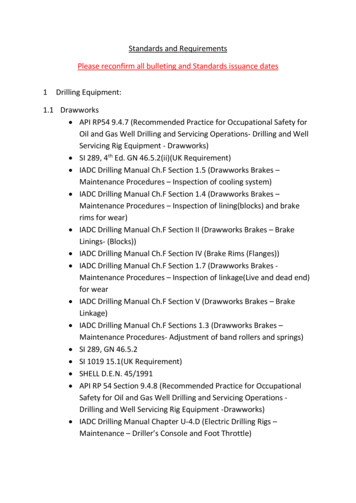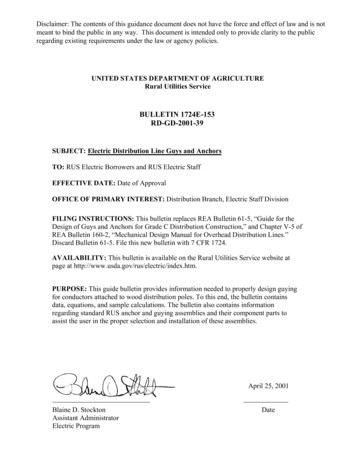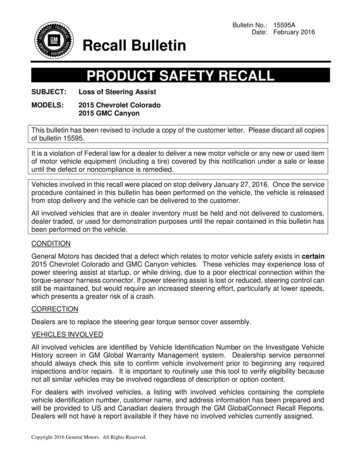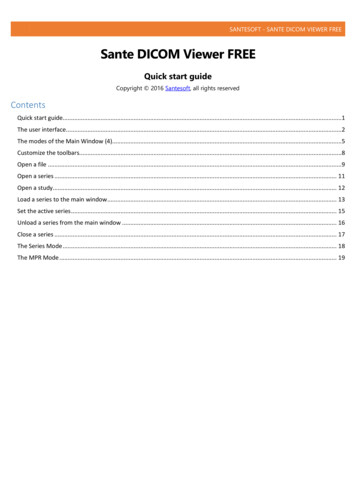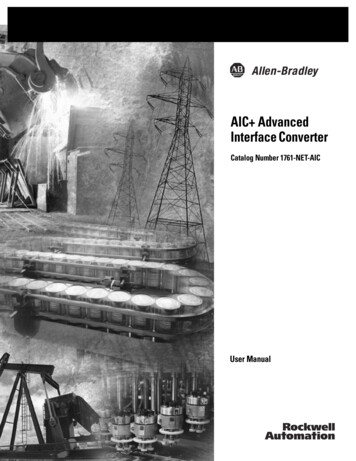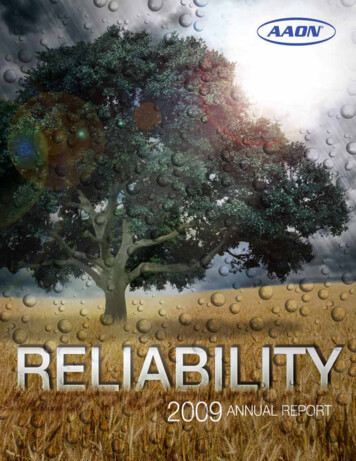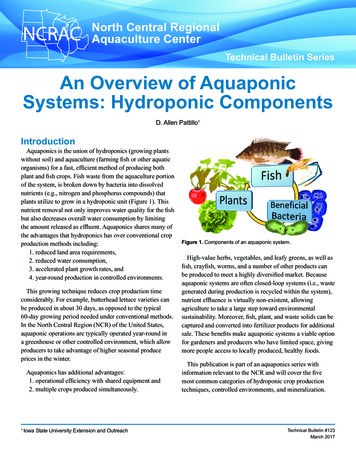
Transcription
Technical Bulletin SeriesNorth Central RegionalAquaculture CenterTechnical Bulletin SeriesAn Overview of AquaponicSystems: Hydroponic ComponentsD. Allen Pattillo1IntroductionAquaponics is the union of hydroponics (growing plantswithout soil) and aquaculture (farming fish or other aquaticorganisms) for a fast, efficient method of producing bothplant and fish crops. Fish waste from the aquaculture portionof the system, is broken down by bacteria into dissolvednutrients (e.g., nitrogen and phosphorus compounds) thatplants utilize to grow in a hydroponic unit (Figure 1). Thisnutrient removal not only improves water quality for the fishbut also decreases overall water consumption by limitingthe amount released as effluent. Aquaponics shares many ofthe advantages that hydroponics has over conventional cropproduction methods including:1. reduced land area requirements,2. reduced water consumption,3. accelerated plant growth rates, and4. year-round production in controlled environments.This growing technique reduces crop production timeconsiderably. For example, butterhead lettuce varieties canbe produced in about 30 days, as opposed to the typical60-day growing period needed under conventional methods.In the North Central Region (NCR) of the United States,aquaponic operations are typically operated year-round ina greenhouse or other controlled environment, which allowproducers to take advantage of higher seasonal produceprices in the winter.Aquaponics has additional advantages:1. operational efficiency with shared equipment and2. multiple crops produced simultaneously.1Iowa State University Extension and OutreachFigure 1. Components of an aquaponic system.High-value herbs, vegetables, and leafy greens, as well asfish, crayfish, worms, and a number of other products canbe produced to meet a highly diversified market. Becauseaquaponic systems are often closed-loop systems (i.e., wastegenerated during production is recycled within the system),nutrient effluence is virtually non-existent, allowingagriculture to take a large step toward environmentalsustainability. Moreover, fish, plant, and waste solids can becaptured and converted into fertilizer products for additionalsale. These benefits make aquaponic systems a viable optionfor gardeners and producers who have limited space, givingmore people access to locally produced, healthy foods.This publication is part of an aquaponics series withinformation relevant to the NCR and will cover the fivemost common categories of hydroponic crop productiontechniques, controlled environments, and mineralization.Technical Bulletin #123March 2017
Technical Bulletin SeriesHydroponic Growing MethodsUsed In AquaponicsThere are many ways to grow plants hydroponically andmany of these techniques have been adapted for use inaquaponic systems. The five most common categories ofhydroponic growing methods used in aquaponic systemsinclude flood and drain, deep water culture, nutrient filmtechnique, drip irrigation, and vertical growing systems.Each of these methods are effective at growing plants, butcertain systems may be favorable under different scenarios.Figure 2 describes the aquaponic system developed at IowaState University.Figure 3. A large flood and drain grow bed.the plant to tolerate their roots sitting in water, duration ofthis cycle will vary. The Iowa State system has successfullygrown leafy greens using a 15-minute flooding and45-minute draining cycle during the 12 daylight hours,which is achieved with a 150 gallon/hour (550 liter/hour)pump on an electric timer.Figure 2. Schematic representation of the aquaponic system usedat Iowa State University.Flood and Drain – Flood and drain (a.k.a. ebb and flow;Figure 3) irrigates the plants by filling the hydroponic unitwith nutrient-rich water followed by a period of draining,which draws air into the root zone. The periodic emersionin water, followed by air exposure, introduces oxygen tothe roots, producing an environment conducive to healthyroots. This method requires the use of a coarse substrate likepea gravel, expanded clay, perlite, and others to support theplant roots, while providing excellent drainage. Flood anddrain systems utilize the substrate for both root stability andthe high surface area of the substrate for biological filtration.Cycling between wet and dry can be controlled byseveral methods including a pump on a timer, an indexingirrigation valve, or the automatic siphon method. Generallyhydroponic units are drained every 20-30 minutes toincorporate oxygen in the root zone. Depending on themoisture holding capacity of the substrate and the ability of2An Overview of Aquaponic Systems: Hydroponic ComponentsAutomatic siphons are used to quickly drain thehydroponic unit. This is generally achieved by using a loopsiphon with either hard or soft plumbing, or a bell siphon(Figure 4). A siphon (Figure 5) occurs when water in avessel at a raised elevation has a tube or pipe submerged init, and that tube, when completely filled with water and noair, creates a vacuum that allows the water to be transportedfrom one vessel to another by gravity flow. A bell siphonuses an inverted chamber encompassing a stand pipe thatFigure 4. A bell siphon chamber (left) and stand pipe inside apermeable pipe (right).
Technical Bulletin Seriescreates an air lockcausing a siphonto form as the airexits from thechamber, and thewater continuesto flow until airis reintroducedinto the chamberthrough the archesat the bottomof the chamber.Flow rate and pipediameter ratios arecritical in creatingthis phenomenon,Figure 5. Basic diagram of a siphon.as greater flowrates are needed to create suction required to evacuate airfrom the chamber. If the gap between the standpipe and thechamber is too great a siphon will not form, but if it is toonarrow the siphon will break before the hydroponic unitis drained.The outflow from the hydroponic unit should be guardedby a permeable pipe (Figure 4) that will hold back thesubstrate while allowing water to flow freely throughit. Care should be taken to keep the plumbing flowunobstructed, as small diameter gravel will tend to fall intothe outflow pipes. In the Iowa State system, an 8-inch (20cm) section of 4-inch (10-cm) diameter corrugated plastictile drain line with 1-inch (25-mm) slots is used to keep thegravel substrate away from the drain.Deepwater Culture – This method, also known asfloating raft culture, is the most commercially adoptedtechnique because of its simplicity and reliability.Deepwater culture (Figure 6) uses a floating or suspendedplatform with holes to support the plants and allows rootsto be submerged in the water. Polystyrene insulation istypically used as the raft and plastic net pots support theplants, although some new food-grade materials have beendeveloped. The rafts provide many benefits including easeof use, mobility, simple cleaning, and lower risk of plantmortality during power outages. Plants in a deep waterculture unit may live up to 2 weeks without water flow oraeration as compared to hours or days in other systems.Figure 6. Deepwater culture using a floating raft.Oxygen content in the water can be a major strugglein deepwater culture because of the high biologicaloxygen demand (BOD), defined as the need for oxygenfor respiration by the plants, animals, and bacteria in thisbiologically-rich system. Aeration should be supplied viadiffusor airstones placed every 4 feet (1.2 meters) under therafts to prevent stagnation and oxygen deprivation in theroot zone.When using this method, water depths may range from4 inches (10 cm) to 3 feet (1 m) or more, but a typicaldepth is 12-24 inches (30-60 cm). Although there arecommercially available containers created specificallyfor deepwater culture of plants, many hobbyists chooseto construct their own using a variety of materials anddimensions. Since many do-it-yourselfers will go to thelocal home improvement store to purchase materials, systemdesigns generally conform to the dimensions of the readilyavailable materials (e.g., 4-foot (1.2-m) increments) toreduce labor. Typical building materials include pressuretreated lumber, galvanized steel tubing, or masonry blocks,all of which are covered with a plastic, polyvinyl chloride(PVC), heavy duty tarp, or rubber pond liner to holdwater. The materials are generally chosen for availability,price, durability, and structural stability depending on thevolume, shape, and life expectancy of the container. Not allconstruction materials are considered food-grade, and careshould be used in their selection, particularly if the produceis to be sold.An Overview of Aquaponic Systems: Hydroponic Components3
Technical Bulletin Seriestubing that ranges in diameter based on the clarity of thewater source and biofouling from bacteria and algae.An advantage to this system is its light-weight design,which allows vertical installation of channels over oneanother or above a deepwater culture system. They shouldbe spaced so light is able to penetrate all crops (Figure 8).The channels are mobile, making it easy to change rowspacing or add or remove channels from the system,creating flexibility for harvest methods.Figure 7. Nutrient film technique (NFT).Nutrient Film Technique (NFT) – The nutrient filmtechnique (Figure 7) utilizes the contact of the root zonewith a thin film of water (approximately 1/4-1/2 inch(5-10 mm) deep) that flows along a smooth surface wherethe roots of the plants can contact both air and watersimultaneously. This is commonly done inside a channelor gutter style system made from white extruded PVCmaterial. These channels vary in width (4-9 in or 10-23 mm)and depth (1.5-4 in or 4-10 cm), depending on the size ofthe plants being grown. Plants like basil and lettuce can begrown in smaller channels, whereas tomatoes, cucumbers,and peppers are grown in larger channels to accommodatethe larger root mass associated with the plants. The slope ofthese systems range between 1 and 4 percent (slope rise/run), and flow rates between 0.25-0.5 gallons (1-2 liters)per minute. Water is delivered into the channels via opaqueSmall diameter irrigation line (spaghetti tubing) isprone to clogging in aquaponic systems and should beavoided. Instead, replace the tubing with 5/8-inch (16-mm)diameter or greater hose (Figure 9). Inadequate flow rates,channelization of water flow, and clogging with massiveroots leading to nutrient deficiencies, wilting, variable cropproduction, and plant mortality.Figure 9. Nutrient film technique modified for aquaponic systemswith a garden hose.Drip Irrigation – Drip irrigation systems (Figure 10) usea substrate for growing plants that provides the root zonewith a constant supply of water and air. Common methodsinclude (Dutch or Bato) bucket culture and slab culture,and are typically used for large fruiting crops like tomatoes,cucumbers, and peppers. Bucket culture combines theconcepts of flood and drain and NFT, creating a modular,mobile growing method for large vining crops. Bucketculture substrates generally include perlite, pea gravel,expanded clay, or rockwool.Figure 8. Nutrient film technique (NFT) installed over deepwater culture.4An Overview of Aquaponic Systems: Hydroponic Components
Technical Bulletin SeriesFigure 11. Slab culture using drip irrigation.Vertical Growing Systems – Vertical growingsystems maximize the production output of a growing areaby taking advantage of the 3-dimensional space, whichmay be important for farmers in urban areas where growingspace can be expensive. Vertical growing may involvemultiple layers of deepwater culture, NFT (Figure 12), floodand drain systems, or growing towers that involve aeroponicgrowing methods, in which the plant roots are suspended inthe air and sprayed with nutrient rich water (Figure 13).Figure 10. Drip irrigation in bucket culture.Slab culture (Figure 11) is similar to NFT culture, butthe water is injected directly into the plant root zone.A commercially available, multi-stage growing methodcommonly used includes small (1-1.5 in or 2.5-4 cmdiameter) starter plugs followed by an intermediate(4x4x4 inch or 10x10x10 cm) block and slab (6x6x24 inor 15x15x60 cm). The substrate is generally covered withplastic to prevent algae growth. Slabs, blocks, and plugsmay be made of rockwool, coconut coir, or other materials.Coconut coir has the added sustainable benefit of beingcompostable.Figure 12. Vertical plant production using deep water cultureand NFT.An Overview of Aquaponic Systems: Hydroponic Components5
Technical Bulletin SeriesTable 1. Required nutrients for plant growth in aquaponicsystems.Nutrient TypeNutrient (symbol)Nitrogen (N)Phosphorus (P)MacronutrientPotassium (K) *Sulfur (S)Calcium (Ca) *Magnesium (Mg)Iron (Fe) *Chlorine (Cl)Molybdenum (Mo)MicronutrientBoron (B)Copper (Cu)Manganese (Mn)Zinc (Zn)* Denotes nutrients typically lacking from fish feeds.Figure 13. Vertical growing tower.A growing tower is designed so that water is pumpedfrom the sump up to the top of the tower and onto a diffuserplate, creating “rain” inside the tower as it drips over theplant roots that are suspended in the air. Towers may beempty (hollow) or filled with a substrate that providesplant structure and aids in water dispersal. Biofouling inan aquaponic system is typical, and vertical systems areparticularly susceptible to clogging and reduced flow ratesthat may starve the plants for water. A routine pressurewashing of system components to remove any biofouling ishighly recommended for success.A mineralization tank (Figure 14) is highly agitated withaeration, creating an opportunity for bacteria to consumewaste products and liberate bioavailable nutrients. Theprocess of bacterial digestion and breakdown of feedgenerally occurs under aerobic (oxygenated) conditions.Periodically aeration is stopped for a period of 20-60 minutes,allowing the solids to settle to the bottom. This processclarifies the water, and the top water layer is then added tothe hydroponic unit.MineralizationFish feed typically has 10 of the 13 required nutrients(Table 1) plants need to thrive under aquaponic growingconditions. The three potential limiting nutrients are calcium(Ca), potassium (K), and iron (Fe). The remaining nutrientsare available for plant uptake after the feed is consumed byfish and later excreted as waste materials. These wastes areprocessed by bacteria present in a mature system.6An Overview of Aquaponic Systems: Hydroponic ComponentsFigure 14. Aerated mineralization tank.Anaerobic digestion is a process that uses bacterialdecomposition in an oxygen-free environment to breakdown the fish waste, producing gasses like methane (CH4)
Technical Bulletin SeriesFigure 15. Polycarbonate greenhouse growing environment.that can be captured and burned as an electricity and heatsource and generate CO2 for plants. This process alsogenerates liquid fertilizer that can be added back to thehydroponic unit and solid fertilizer that can be used in thegermination of seedling plants.Recent research suggests that a combination of aerobicand anaerobic digestion techniques may benefit plantnutrient availability. Variations on these techniques mayprovide the optimal combined benefits of aerobic andanaerobic waste digestion.Controlled Growing EnvironmentThe growing environment is critical for plant production.At present, the majority of available reliable aquaponicsresearch has been conducted in tropical climates wheregrowing conditions are ideal year-round. In the NCR, however,hot summers and cold winters tend to limit the growingseason and production options available to producers.Research and extension efforts are currently underway toeducate producers on optimized techniques in the NCR.The ability to regulate temperature, light intensity,humidity, and to shelter the production system fromthe elements helps optimize growth rates for crops aswell as ensure biosecurity and food safety. A controlledenvironment may be a warehouse, classroom, basement,garage, greenhouse, or other structure that shieldsthe growing system from the external environment.Greenhouses (Figure 15) are commonly used for year-roundcrop production because of their heat retention and thetransmission of sunlight through the structure. Warehouseshave become popular for vertical growing systems becauseof their availability in or near cities and their ability toinsulate the crops from prevailing weather conditions. Awarehouse environment will require the use of artificiallight, a major energy input. Farmers can work with theirlocal power company to obtain reduced electrical pricingrates by using ‘off-peak’ power when the typical energydemand by other consumers is low (i.e., nights, weekends,and holidays). Operational efficiency can be gained byusing the heat generated by certain types of grow lightsand pumps used in the system to somewhat reduce heatingrequirements. Additionally, some producers choose togenerate their own electricity with an internal combustiongenerator, creating electricity, heat, and carbon dioxide – allbeneficial in plant production.Renewable energy sources are growing in popularity andbecoming more affordable for producers. Some governmentprograms provide incentives for using renewable energysources as well. Solar and wind energy are ways to reducea farm’s carbon footprint and become more energeticallyindependent from the power grid. Geothermal heating andcooling is one option for curtailing the summer and wintertemperature variations experienced by greenhouse growersin the NCR. Installing these types of systems generallyrequires a large investment, so farmers considering theseoptions should look into the capital cost of the infrastructureand compare it to the equipment’s useful lifespan as well thepayback period required to recoup the upfront cost.ConclusionsAquaponic systems present a unique opportunity foryear-round production of plants and fish. Out-of-seasonproduction of leafy greens, herbs, and vegetables can bea major source of income for aquaponic producers, asthey can take advantage of much higher seasonal prices.The high quality and freshness of aquaponic produce ishighly desired by chefs in metropolitan areas. If aquaponicproducers can fill the seasonal gaps with fresh produce,buyers are more likely to keep them as a vendor, allowingproducers to capture a larger market share. Additionally,the local foods movement and consumer willingness topay more for a superior product is a major advantage toaquaponic producers.Aquaponics can be done on a wide range of scales;from a bench-top aquarium for the hobbyist to a multiacre commercial facility capable of producing substantialamounts of fish and plants per year. As in other agricultureoperations, profitability in the aquaponics businessmodel is related to scale and efficiency of production.An Overview of Aquaponic Systems: Hydroponic Components7
Technical Bulletin SeriesResearch conducted at Iowa State suggests that it may bepossible to generate a profit when producing tilapia andbasil in a greenhouse facility in Iowa. This system modeldemonstrates that the value of the fish (tilapia) producedhas very little effect on profitability, but rather the priceand amount of plants (basil) produced often determineseconomic viability.Aquaponics may be an attractive opportunity forindividuals wanting to change their lifestyle to a slower pacewith a modest income. In a well-designed and efficientlyrun aquaponics facility, the ability to profit is greater as theplant growing area increases because of increased productoutput, efficient use of resources, stability of the system, andregularity of production. However, a larger facility does notnecessarily mean more profit. One should consider supplyand demand principles and wholesale versus retail pricingto determine the actual returns to the farmer. It is critical,therefore, for potential aquaponic farmers to do their duediligence in business planning and market research as wellas hands-on education prior to investing in an aquaponicsbusiness to ensure success.Suggested ReadingsAko, H. 2014. How to Build and Operate a Simple Small-to-Large Scale Aquaponics System. Center for Tropicaland Subtropical Aquaculture Center Publication 161.Available: http://www.ctsa.org/files/publications/CTSA aquaponicsHowTo.pdf (Accessed March 3, 2017)Ako, H. and A. Baker. 2009. Small-Scale Lettuce Production with Hydroponics or Aquaponics. SustainableAgriculture SA-2. College of Tropical Agriculture and Human Resources. University of Hawaii at Manoa.Available: s.pdf(Accessed March 3, 2017)Burden, D. J. and D. A. Pattillo. 2013. Aquaponics. Agriculture Marketing Resource Center.Available: ure/aquaponics/ (Accessed March 3, 2017)Conte, F. S. and L. C. Thompson. 2012. Aquaponics. California Aquaculture Extension.Available: .pdf (Accessed March 3, 2017)Diver, S. 2006. Aquaponics – Integration of Hydroponics with Aquaculture. ATTRA.Available: https://attra.ncat.org/attra-pub/download.php?id 56 (Accessed March 3, 2017)Duncan, P. 2013. Introduction to Aquaponics Systems and Management.Available: ed March 3, 2017)Engle, C. R. 2015. Economics of Aquaponics. Southern Regional Aquaculture Center Publication Number 5006.Available: https://srac-aquaponics.tamu.edu/serveFactSheet/8 (Accessed March 3, 2017)Fox, B. K., R. Howerton, and C. S. Tamaru. 2010. Construction of Automatic Bell Siphons for Backyard Aquaponic Systems.Biotechnology BIO-10. University of Hawaii at Manoa. Available: .pdf(Accessed March 3, 2017)Kelly, A. M. 2015. Is Aquaponics for You? Realities and Potentials for Arkansas. University of Arkansas at Pine BluffExtension. Available: ion/p266101coll7/id/28963(Accessed March 3, 2017)Kelly, A. M. 2013. Aquaponics. University of Arkansas Pine Bluff Extension.Available: 2.pdf (March 3, 2017)8An Overview of Aquaponic Systems: Hydroponic Components
Technical Bulletin SeriesMullins, B. Nerrie, and T. D. Sink. 2015. Principles of Small-Scale Aquaponics. Southern Regional Aquaculture CenterPublication Number 5007. Available: https://srac-aquaponics.tamu.edu/serveFactSheet/9 (Accessed March 3, 2017)Pattillo, D. A. 2015. Aquaponics Production Data: Loss or Profit? Iowa State University Extension and Outreach.Available: Allen%20Patillo.pdf (Accessed March 3, 2017)Pattillo, D. A. 2015. Aquaponics: Food Safety & Human Health. Iowa State University Extension and Outreach.Available: 20Patillo.pdf (Accessed March 3, 2017)Pattillo, D. A. 2014. Aquaponic System Design and Management. Iowa State University Extension and Outreach.Available: www.extension.iastate.edu/forestry/tri state/tristate 2014/talks/PDFs/Aquaponic System Designand Management.pdf (Accessed March 3, 2017)Rakocy, J. E., M. P. Masser, and T. M. Losordo. 2006. Recirculating Aquaculture Tank Production Systems:Aquaponics – Integrating Fish and Plant Culture. Southern Regional Aquaculture Center Publication Number 454.Available: https://srac.tamu.edu/serveFactSheet/105 (Accessed March 3, 2017)Rakocy, J. E., D. S. Bauley, R. C. Shultz, and J. J. Danaher. A Commercial-Scale Aquaponic System Developed atthe University of the Virgin Islands. Available: /Rakocy1.doc(Accessed March 3, 2017)Resh, H. M. 1995. Hydroponic food production: a definitive guidebook for the advanced home gardener and thecommercial hydroponic grower, 6th Edition. Newconcept Press, Inc., Mahwah, New Jersey.Rosen, C. J. P. M. Bierman, R. D. Eliason. Soil pH Modification. 2014. eXtension.org.Available: fication#.VAh2yhCwWSo (Accessed March 3, 2017)Sanders, D. 2001. Lettuce: Horticulture Information Leaflet. North Carolina Extension.Available: http://content.ces.ncsu.edu/lettuce (Accessed March 3, 2017)Sawyer, J. D. 2013. Aquaponics: Growing Fish and Plants Together. Colorado Aquaponics.Available: -Growing-Fish-and-Plants-Together.pdf(Accessed March 3, 2017)Somerville, C. Cohen, M. Pantanella, E. Stankus, A. and Lovatelli, A. 2014. Small-scale aquaponic food production:Integrated fish and plant farming. Food and Agriculture Organization of the United Nations: Fisheries andAquaculture Technical Paper 589. Available: http://www.fao.org/3/a-i4021e.pdf (Accessed March 3, 2017)Timmons, M. B. and J. M. Ebeling. 2013. Recirculating Aquaculture, 3rd Edition. Pp. 663-710. Northeastern RegionalAquaculture Center Publication No. 401-2013.Tyson, R. 2013. Aquaponics – Vegetable and Fish Co-Production 2013. University of Florida Extension.Available: d March 3, 2017)An Overview of Aquaponic Systems: Hydroponic Components9
Technical Bulletin SeriesRecommended VideosDanaher, J. 2015. Aquaponics – An Integrated Fish and Plant Production System. Southern Regional Aquaculture Center.Available: ish-and-plant-production-system (Accessed March 3, 2017)Pattillo, D. A. 2016. Aquaponics: How to Do It Yourself! North Central Regional Aquaculture Center Webinar Series.Accessed: urself (Accessed March 3, 2017)Pattillo, D. A. 2013. Aquaponics System Design and Management. Iowa State University Extension and Outreach.Available: ?launcher false&fcsContent true&pbMode normal(Accessed March 3, 2017)Rode, R. 2013. Aquaponics. Available: https://www.youtube.com/watch?v 26xpMCXP9bw (Accessed March 3, 2017)Ron, B. T. 2014. Aquaponics: Paradigm Shift with Airlift. eXtension.org.Available: https://www.youtube.com/watch?v ZWGs4NIkrLs&feature em-upload owner (Accessed March 3, 2017)Ron, B. T. 2014. Aquaponics: Paradigm Shift with Airlift Pumps Part 2. eXtension.org.Available: https://www.youtube.com/watch?v 1EDlMqrngqQ&feature em-upload owner (Accessed March 3, 2017)Resource PagesAgricultural Marketing Resource Center http://www.agmrc.org/Aquaponics Association http://aquaponicsassociation.org/Aquaponics Journal http://aquaponicsjournal.comATTRA National Center for Appropriate Technology https://attra.ncat.org/Iowa State University Extension Online Store https://store.extension.iastate.eduIowa State University Food Safety Extension http://www.extension.iastate.edu/foodsafety/Iowa State University Fisheries Extension http://www.nrem.iastate.edu/fisheries/Leopold Center for Sustainable Agriculture https://www.leopold.iastate.edu/North Central Regional Aquaculture Center www.ncrac.orgSouthern Regional Aquaculture Center – Aquaponics Publication Series https://srac-aquaponics.tamu.edu/Sustainable Agriculture Research and Education Program http://www.sare.org/USDA – National Agricultural Library y of Minnesota Aquaponics /Texas A&M Aquaponics http://fisheries.tamu.edu/aquaponics/Photos and figures provided by D. Allen Pattillo.This material is based upon work that is supported by the National Institute of Food and Agriculture,U.S. Department of Agriculture, under award number 2012-38500-19550. Any opinions, findings,conclusions, or recommendations expressed in this publication are those of the author(s) and do notnecessarily reflect the view of the U.S. Department of Agriculture.10An Overview of Aquaponic Systems: Hydroponic Components
Aquaponics is the union of hydroponics (growing plants without soil) and aquaculture (farming fish or other aquatic organisms) for a fast, efficient method of producing both plant and fish crops. Fish waste from the aquaculture portion of the system, is broken down by bacteria into dissolved

